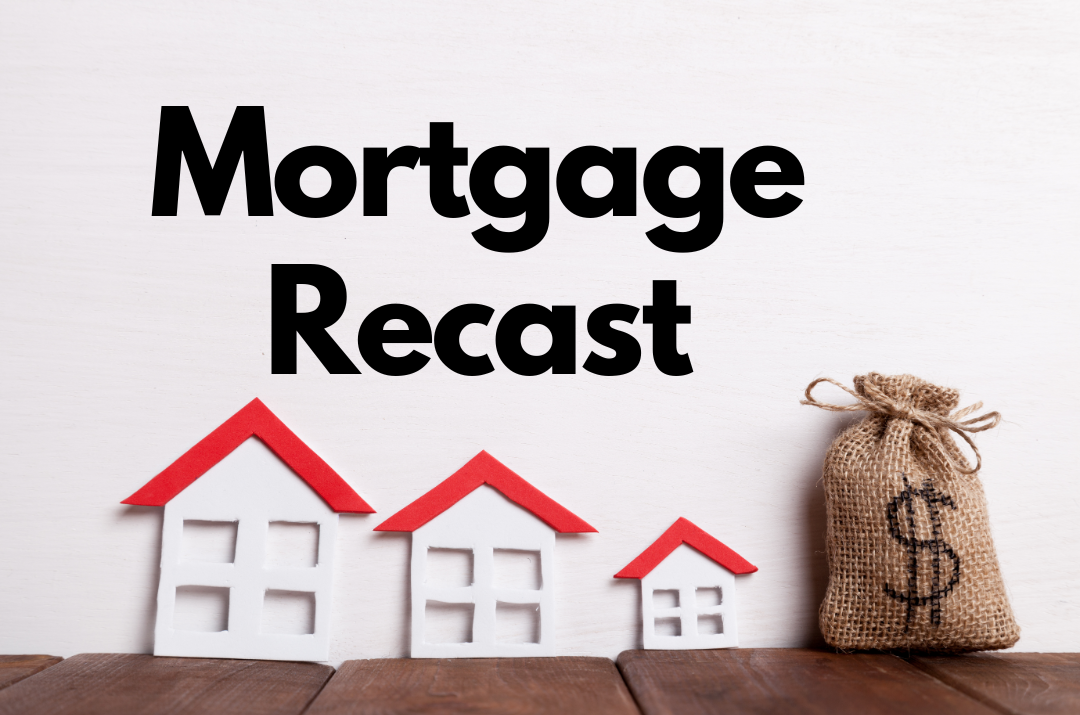A Mortgage Recasting is a feature of some types of mortgages where remaining monthly payments are recalculated based on a new amortization schedule. During the process of Mortgage Recasting, the homebuyers pay a large sum towards their principal, and their mortgage is then recalculated based on the new lower balance outstanding. Mortgage Recasting is a way to change how much the homeowners pay monthly without refinancing their Mortgage. The Mortgage lender will apply extra funds to their loan balance, and then recalculate how much they have to pay each month.
Mortgage Recasting does not mean the homeowners will pay off their mortgage early. The homebuyer’s new payoff schedule matches what it would have been originally but with each monthly payment adjusted to reflect the new Balance. A Mortgage Recasting occurs when a homebuyer pays a large sum toward their mortgage principal and the lender recalculates the Mortgage Loan based on the new loan balance. The main benefit of Mortgage Recasting to homebuyers is the opportunity to reduce the monthly Payments. Mortgage Recasting is an arrangement with lenders to apply a large amount of cash towards their principal.
Mortgage Recasting is when a lender recalculates the monthly mortgage payments on their current loan based on the outstanding balance and remaining loan term. When a borrower purchases a home, their lender calculates mortgage payments based on the principal balance and loan term. Every time the homeowners make a payment, their balance goes down. When a borrower pays towards their mortgage ahead of schedule, it may make sense to request a mortgage recasting. When homebuyers refinance their home, they Apply to create a new loan with different interest rates and different terms or to take out equity.
What Is Mortgage Recasting?
Mortgage Recasting is the process of reducing Mortgage balance through a lump-sum payment and then making smaller monthly payments until they pay off their Mortgage Loan. Unlike Mortgage Refinancing, Mortgage Recasting does not change loan terms or interest rates and homebuyers will simply have lower monthly payments, but they will also save on interest payments over the life of the Loan. If the Mortgage lender does not offer Mortgage Recasting, they can make a lump-sum payment on their mortgage. Doing so will decrease the Loan balance, but their monthly payment will stay the same. still, they will be able to pay off their loan early if homebuyers go this route.

How Does Mortgage Recasting Work?
When a homebuyer recasts their Mortgage, They will pay a large chunk of money towards their principal balance and request a reamortization of their Mortgage Loan. For some people, this could be an option after receiving an inheritance or coming into a large sum of money. Mortgage Recasting is not automatic, and it does involve some processing time. The homebuyers will likely need to submit an official request to the Mortgage servicer to initiate the process. Since the borrowers are not changing the interest rates or terms of their Mortgage Loan. they won’t need to complete much additional documentation or go through a credit check. However, homebuyers need to wait six to eight weeks for the lender to complete their new schedule. They will also need to sign a new agreement with their new payment obligation as well as pay a fee typically a few hundred dollars. Otherwise, the process is fairly straightforward.
What Requirements are Needed for Mortgage Recasting?
Here is what the homebuyers typically need to Mortgage Recasting:
- A principal reduction of $10,000 or more.
- The one-time cost should be approximately $500.
- There is no paperwork involved.
- The Loan must be current with a 12-month on-time payment history.
- A mortgage recasting process does not require any underwriting or mortgage documentation similar to a mortgage loan process.
How To Qualify For Mortgage Recasting?
Every servicer has their own specific rules to qualify for Mortgage Recasting. However, Here are some guidelines that can give homebuyers an idea of how to qualify for mortgage recasting:
- Mortgage Types: The homeowners can not process the Mortgage Recasting for government-sponsored loans, which include mortgages insured by the Federal Housing Administration, U.S. Department of Agriculture, or U.S. Department of Veterans Affairs. Most Jumbo Loans, which are mortgage loans that exceed the Conforming Loan Limits are also excluded for Mortgage Recasting.
- Lump Sum of Cash: Homebuyers need to pay the minimum amount to qualify for Mortgage Recasting. The homeowners are usually required to put at least $5000 toward the loan principal or percentage toward the loan balance.
- Administrative Fee: The homebuyers may need to pay their loan servicer a fee for the Mortgage Recasting. The fee usually ranges from $250 to $500 though some mortgage lenders waive it.
- On-time Payment History: Mortgage lenders want to see 6 or 12 months of on-time payments before they recast.
- Equity Requirements: The Mortgage Loan servicer may expect the homebuyers to have a certain amount of equity in the home. It may be either a fixed dollar amount or a percentage of the principal balance.
- Time Frame: The homebuyers may need to wait a minimum period after Closing on the Loan about 90 days before they can Recast the Mortgage.
What is the Process of Mortgage Recasting?
Here is the complete step-by-step process for Mortgage Recasting:
- Contact the Mortgage lender to Determine the eligibility: Not all mortgage lenders offer Mortgage Recasting, which is why it is most important to confirm availability with the mortgage lenders before setting aside funds. Some types of Mortgages like those backed by FHA or VA are not eligible for the Mortgage Recasting. However, the mortgage lender will tell the homebuyers if their mortgage is eligible or not.
- Save money for Extra Payments: In addition to confirming that borrowers’ mortgages can be Recast, they need to find out if their mortgage lender has minimum lump-sum payments. This amount is usually between a percentage of their outstanding mortgage balance usually up to 10%.
- Request to Recast the Loan: When a homebuyer is ready to proceed with Mortgage Recasting then they would need to submit the formal request to their lender. Most mortgage lenders charge a fee of up to $500 for Mortgage Recasting, however, this fee may vary. That fee is significantly lower than the homebuyers would pay to refinance the home loan. Once approved, the homeowners need to make their lump-sum payment against their outstanding mortgage balance.
- Continue Making Payments: After Mortgage Recasting, the monthly loan payment will be lower based on the remaining balance. However, the Mortgage Recasting process can take weeks to complete once the borrowers have made their payments and it is important to continue regular payments in the meantime. Once the homeowners receive notification that their Mortgage Recasting is completed, then start making their newly calculated payments.
How To Calculate Mortgage Recasting Payment?
The homeowners can use the Mortgage Recasting calculator to estimate their new monthly payment and interest payment after paying down their principal. The interest rate and remaining years until the payoff date remain the same. mortgage recasting only adjusts the mortgage principal and interest payments.
Mortgage Recasting Reviews
Mortgage Recasting is a good option when the homebuyers can afford a large upfront payment to reduce the payment and lifetime interest costs on a qualifying conventional mortgage or jumbo mortgage. Homebuyers avoid the closing and lengthy underwriting process of a mortgage refinance if they can’t qualify for a lower interest rate and don’t need to extend their repayment period. Here are some Pros and Cons of Mortgage Recasting:
Pros:
- The monthly mortgage payment decreases.
- The Mortgage lender does not perform a credit check.
- The homebuyers won’t pay the closing costs.
- A Home Appraisal is not required for Mortgage Recasting.
- The administrative fee is relatively low.
Cons:
- Mortgage Recasting does not shorten the length of the Mortgage.
- Not all Mortgage lenders or Servicers allow Mortgage Recasting,
- The homebuyers will need to come up with a large lump-sum payment.
- The money used for payment won’t be available for other purposes such as investing.
- The loan’s rate of interest does not change.
Frequently Asked Questions (FAQs)
Question 1: How much does it cost to recast a Mortgage Loan?
Answer: Many Mortgage Lenders charge $250, or less in Mortgage Recast fees, although the Mortgage Recasting fees can be as much as $500.
Question 2: Is Mortgage Recasting a good idea?
Answer: Mortgage Recasting is a good option when homebuyers need to reduce their monthly payments and can afford a large upfront principal reduction.
Question 3: How does Mortgage Recasting differ from making principal payments?
Answer: Mortgage Recasting differs from simply making principal payments because it reamortizes the mortgage loan.
Question 4: Is it a good idea to recast the Mortgage Loan?
Answer: Mortgage Recasting can help homebuyers lower their monthly payments without the sizable closing costs associated with refinancing. It’s important to note, however, that Mortgage Recasting requires to make a lump sum payment.
The Final Verdict
Mortgage recasting is worth looking into for lowering the monthly mortgage payments if the homeowner’s current mortgage interest rate is low and they have substantial cash to put toward their home equity. But first, it’s important to consider if their money might serve them better if they use it differently. Mortgage Recasting might be a smart decision to chip away at Borrowers’ principal, reduce their monthly payments, and save on interest.
